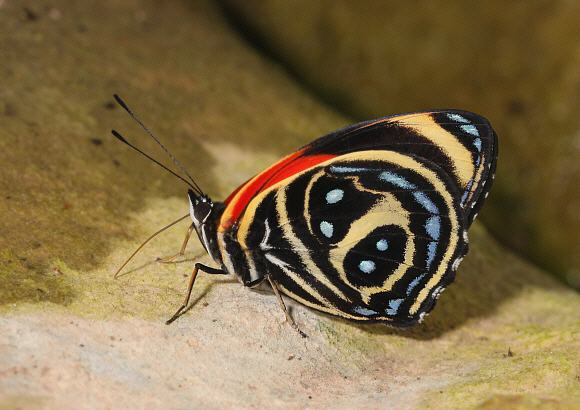 Callicore texa maimuna, Satipo, Peru – Adrian Hoskins
Callicore texa maimuna, Satipo, Peru – Adrian Hoskins
Introduction
There are about 20 species in the genus Callicore, all of which bear distinctive and graphic patterns on the underside hindwings, often resembling numbers or letters of the alphabet. The uppersides of all species are blackish, marked on the forewings with bright red or orange bands. The hindwings of several species also have red or orange markings but in most species they are plain black, with a very reflective brilliant blue sheen.
Unfortunately these beautiful butterflies are killed in vast numbers for their wings which are used by the souvenir trade for the production of decorated plates, jewellery, place mats and other trivia.
In Callicore texa maimuna the upperside forewings of both sexes are black with a broad red swathe running diagonally and a pinkish crescent at the apex. The hindwings are dark brown, with a row of metallic blue submarginal spots which are more pronounced in the female. In some subspecies such as maximilla ( Brazil ) there is a large red patch on the upperside hindwing.
Callicore texa is distributed from Mexico to Bolivia. The illustrated subspecies maimuna is found in the upper Amazonian region of Peru.
Habitats
Tropical rainforest at altitudes between circa 200-900m.
Lifecycle
I have no information specific to texa. In most Callicore species the eggs are white, and are laid singly on Serjania, Allophylus or other Sapindaceae.
Adult behaviour
Males often visit river beaches to imbibe dissolved minerals. On hot sunny days they habitually land on the arms, legs and backs of humans to imbibe sweat. For photographers this behaviour can be maddening, as no matter how many times you shoo the butterfly off and try to cajole it into settling on a natural substrate, it insists on returning immediately to land on your trousers, shoulder, boots or camera bag. Moreover the longer you spend trying to get a photograph the braver the butterfly becomes, and the more likely it is to glue itself to your back or the top of your head !
